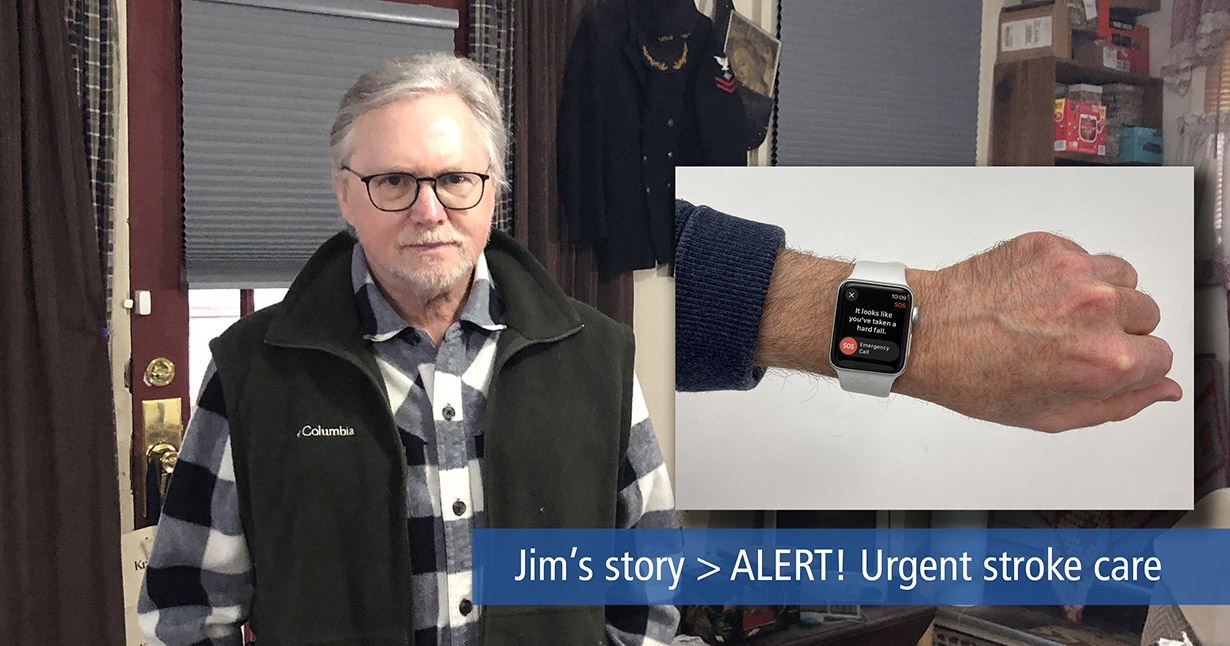
Jim's story
Large vessel occlusion, mechanical thrombectomy
Alert from Jim's watch helps him get quick treatment for a stroke
Jim was looking at his computer one afternoon in his Northern Kentucky home, when he just fell off the chair.
"I didn't feel like I had any symptoms or anything. I just thought I leaned forward and fell out of the chair," Jim said. "I was lying there and I thought, 'Why am I not getting up?'"
That's where Jim's Apple Watch kicked in, sending an automatic fall alert to EMS and to his brother (the fall alert is automatic for people who register a birth date showing they are older than 55). In only a matter of minutes, emergency workers arrived and found him on the floor.

Jim was having a stroke – on his 69th birthday.
He was taken first to St. Elizabeth Hospital in Fort Thomas, where physicians determined he had suffered a large vessel occlusion, the most serious type of ischemic stroke in which a blockage keeps blood from flowing to the brain. He then was transferred to St. Elizabeth in Edgewood, where Mayfield Brain & Spine neurosurgeon Dr. Michael Robinson performed a surgery called a thrombectomy, removing the clot and restoring blood flow.
"I think I was aware enough to know that I was in serious trouble," Jim recalled. "When he actually got the clot, I think I remember him saying, 'I got it.'"
The alert from Jim's watch clearly kept him from greater damage to his brain function and probably saved his life. For those suffering a stroke, getting into treatment quickly and removing the blockage to the brain is critical in promoting a full recovery.
"Quick recognition of stroke symptoms means better outcomes for patients like Jim," Dr. Robinson said. "The prompt response by EMS and their immediate recognition of some of the classic symptoms of an ischemic stroke, including drooping on one side of his face, made all the difference in his outcome. Thanks to the advanced equipment and specially trained clinicians at St. Elizabeth in Edgewood, we were able to remove the blockage efficiently, minimizing any symptoms from the stroke."
In October 2023, Mayfield and St. Elizabeth announced the ability to complete thrombectomy surgeries at the Edgewood hospital. Leading-edge biplane technology in the angiography suite includes two mobile cameras that allow for imaging of the brain from multiple perspectives, helping physicians track blood flow, identify blockages and pinpoint the location of the blockage. Previously, Northern Kentucky patients suffering a severe ischemic stroke were transported to a Cincinnati hospital for surgery to remove the blockage.
After two nights in the hospital, Jim went home. If he hadn't gotten to the hospital quickly or if the blockage couldn't have been removed, he might have faced weeks in the hospital, months of rehab and an uncertain prospect for independence. But today, he feels mostly back to normal. He is back driving and living on his own.
"Everything seemed to work, and I'm really grateful," he said. "I think I'm one of the luckiest people in the world."
~ Cliff Peale
Hope Story Disclaimer -"Jim's Story" is about one patient's health-care experience. Please bear in mind that because every patient is unique, individual patients may respond to treatment in different ways. Results are influenced by many factors and may vary from patient to patient.
